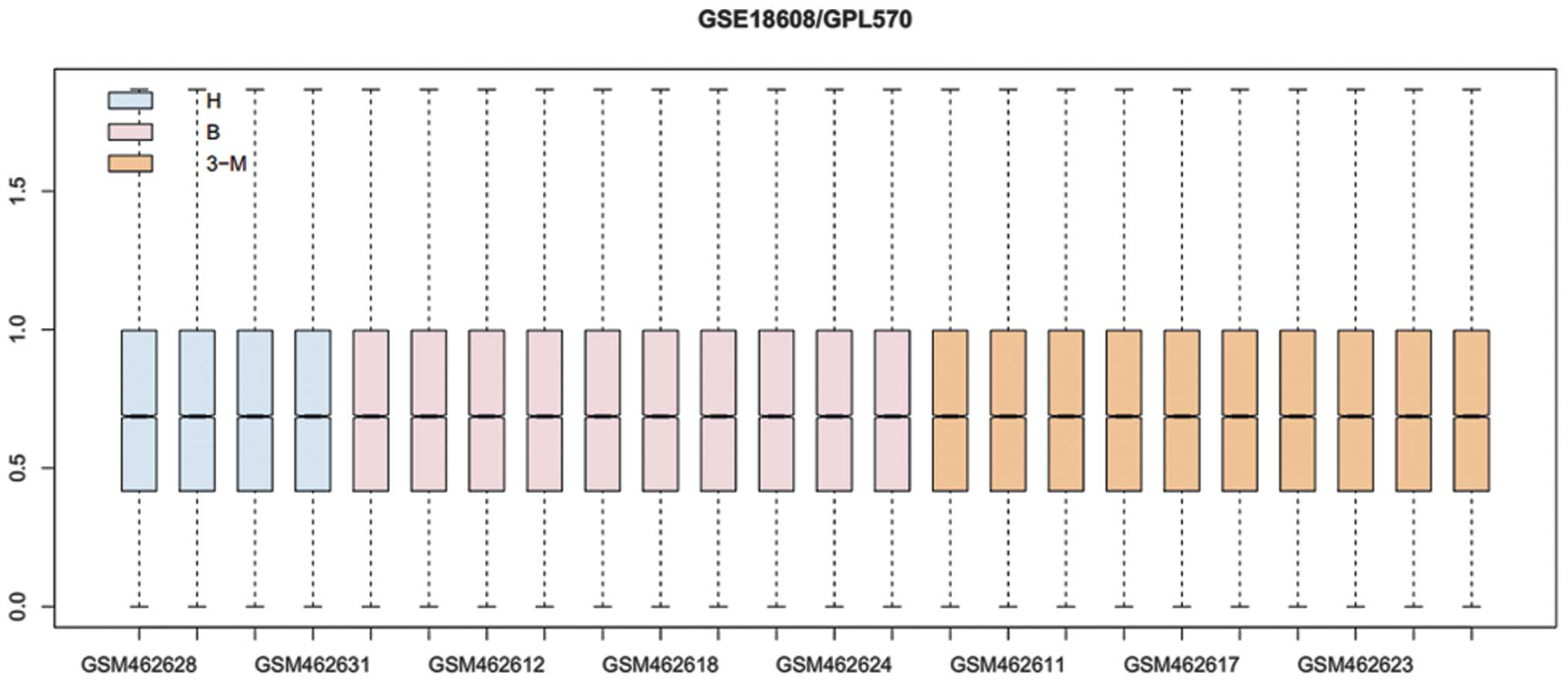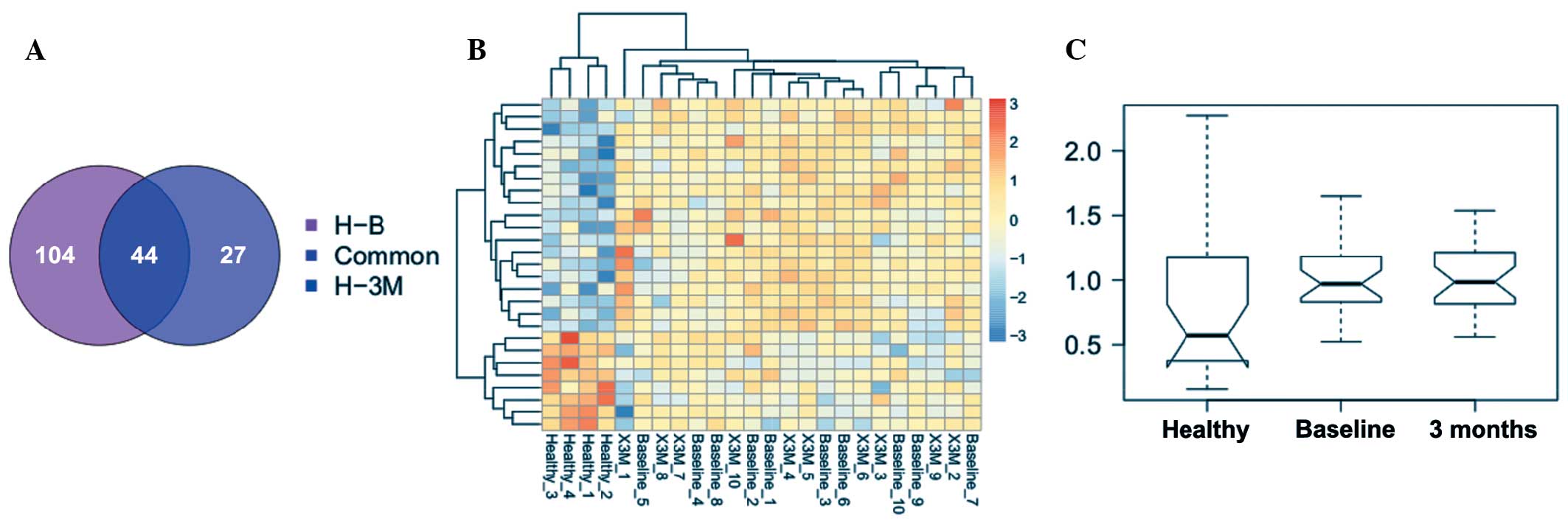|
1
|
Landmesser U and Drexler H: Chronic heart
failure: An overview of conventional treatment versus novel
approaches. Nat Clin Pract Cardiovasc Med. 2:628–638. 2005.
View Article : Google Scholar : PubMed/NCBI
|
|
2
|
Ford ES, Ajani UA, Croft JB, Critchley JA,
Labarthe DR, Kottke TE, Giles WH and Capewell S: Explaining the
decrease in U.S. deaths from coronary disease, 1980–2000. N Engl J
Med. 356:2388–2398. 2007. View Article : Google Scholar : PubMed/NCBI
|
|
3
|
Landmesser U, Wollert KC and Drexler H:
Potential novel pharmacological therapies for myocardial
remodeling. Cardiovasc Res. 81:519–527. 2009. View Article : Google Scholar
|
|
4
|
Schächinger V, Erbs S, Elsässer A,
Haberbosch W, Hambrecht R, Hölschermann H, Yu J, Corti R, Mathey
DG, Hamm CW, et al: Improved clinical outcome after intracoronary
administration of bone-marrow-derived progenitor cells in acute
myocardial infarction: Final 1-year results of the REPAIR-AMI
trial. Eur Heart J. 27:2775–2783. 2006. View Article : Google Scholar : PubMed/NCBI
|
|
5
|
Segers VF and Lee RT: Stem-cell therapy
for cardiac disease. Nature. 451:937–942. 2008. View Article : Google Scholar : PubMed/NCBI
|
|
6
|
Schots R, De Keulenaer G, Schoors D,
Caveliers V, Dujardin M, Verheye S, Van Camp G, Franken PR, Roland
J, Van Riet I and Everaert H: Evidence that intracoronary-injected
CD13+ peripheral blood progenitor cells home to the myocardium in
chronic postinfarction heart failure. Exp Hematol. 35:1884–1890.
2007. View Article : Google Scholar : PubMed/NCBI
|
|
7
|
Bartunek J, Vanderheyden M, Vandekerckhove
B, Mansour S, De Bruyne B, De Bondt P, Van Haute I, Lootens N,
Heyndrickx G and Wijns W: Intracoronary injection of CD133-positive
enriched bone marrow progenitor cells promotes cardiac recovery
after recent myocardial infarction: Feasibility and safety.
Circulation. 112:I178–I183. 2005.PubMed/NCBI
|
|
8
|
Ahmadi H, Baharvand H, Ashtiani SK,
Soleimani M, Sadeghian H, Ardekani JM, Mehrjerdi NZ, Kouhkan A,
Namiri M, Madani-Civi M, et al: Safety analysis and improved
cardiac function following local autologous transplantation of
CD133+ enriched bone marrow cells after myocardial infarction. Curr
Neurovasc Res. 4:153–160. 2007. View Article : Google Scholar : PubMed/NCBI
|
|
9
|
Klein H, Ghodsizad A, Marktanner R, Poll
L, Voelkel T, Mohammad Hasani MR, Piechaczek C, Feifel N,
Stockschlaeder M, Burchardt ER, et al: Intramyocardial implantation
of CD133+ stem cells improved cardiac function without bypass
surgery. Heart Surg Forum. 10:E66–E69. 2007. View Article : Google Scholar
|
|
10
|
Bonanno G, Mariotti A, Procoli A, Corallo
M, Rutella S, Pessina G, Scambia G, Mancuso S and Pierelli L: Human
cord blood CD133+ cells immunoselected by a clinical-grade
apparatus differentiate in vitro into endothelial- and
cardio-myocyte-like cells. Transfusion. 47:280–289. 2007.
View Article : Google Scholar : PubMed/NCBI
|
|
11
|
Heeschen C, Lehmann R, Honold J, Assmus B,
Aicher A, Walter DH, Martin H, Zeiher AM and Dimmeler S: Profoundly
reduced neovascularization capacity of bone marrow mononuclear
cells derived from patients with chronic ischemic heart disease.
Circulation. 109:1615–1622. 2004. View Article : Google Scholar : PubMed/NCBI
|
|
12
|
Scheubel RJ, Zorn H, Silber RE, Kuss O,
Morawietz H, Holtz J and Simm A: Age-dependent depression in
circulating endothelial progenitor cells in patients undergoing
coronary artery bypass grafting. J Am Coll Cardiol. 42:2073–2080.
2003. View Article : Google Scholar : PubMed/NCBI
|
|
13
|
Liu D, Glaser AP, Patibandla S, Blum A,
Munson PJ, McCoy JP, Raghavachari N and Cannon RO: Transcriptional
profiling of CD133(+) cells in coronary artery disease and effects
of exercise on gene expression. Cytotherapy. 13:227–236. 2011.
View Article : Google Scholar : PubMed/NCBI
|
|
14
|
Fujita A, Sato JR, Rodrigues Lde O,
Ferreira CE and Sogayar MC: Evaluating different methods of
microarray data normalization. BMC Bioinformatics. 7:4692006.
View Article : Google Scholar : PubMed/NCBI
|
|
15
|
Smyth GK: Limma: Linear models for
microarray data. Bioinformatics and computational biology solutions
using R and Bioconductor. Springer; pp. 397–420. 2005, View Article : Google Scholar
|
|
16
|
Benjamini Y and Hochberg Y: Controlling
the false discovery rate: a practical and powerful approach to
multiple testing. Journal of the Royal Statistical Society. Series
B (Methodological). 289–300. 1995.
|
|
17
|
Kolde R: Pheatmap: Pretty heatmaps. R
package version 0.6. 1:2012.
|
|
18
|
Huang DW, Sherman BT and Lempicki RA:
Systematic and integrative analysis of large gene lists using DAVID
bioinformatics resources. Nat Protoc. 4:44–57. 2009. View Article : Google Scholar
|
|
19
|
Evan GI and Vousden KH: Proliferation,
cell cycle and apoptosis in cancer. Nature. 411:342–348. 2001.
View Article : Google Scholar : PubMed/NCBI
|
|
20
|
Catania A, Urban S, Yan E, Hao C and
Barron Gand Allalunis-Turner J: Expression and localization of
cyclin-dependent kinase 5 in apoptotic human glioma cells. Neuro
Oncol. 3:89–98. 2001.PubMed/NCBI
|
|
21
|
Braz JC, Gregory K, Pathak A, Zhao W,
Sahin B, Klevitsky R, Kimball TF, Lorenz JN, Nairn AC, Liggett SB,
et al: PKC-alpha regulates cardiac contractility and propensity
toward heart failure. Nat Med. 10:248–254. 2004. View Article : Google Scholar : PubMed/NCBI
|
|
22
|
Hambleton M, York A, Sargent MA, Kaiser
RA, Lorenz JN, Robbins J and Molkentin JD: Inducible and
myocyte-specific inhibition of PKCalpha enhances cardiac
contractility and protects against infarction-induced heart
failure. Am J Physiol Heart Circ Physiol. 293:H3768–H3771. 2007.
View Article : Google Scholar : PubMed/NCBI
|
|
23
|
Hambleton M, Hahn H, Pleger ST, Kuhn MC,
Klevitsky R, Carr AN, Kimball TF, Hewett TE, Dorn GW 2nd, Koch WJ
and Molkentin JD: Pharmacological- and gene therapy-based
inhibition of protein kinase Calpha/beta enhances cardiac
contractility and attenuates heart failure. Circulation.
114:574–582. 2006. View Article : Google Scholar : PubMed/NCBI
|
|
24
|
Rohr S, Bit-Avragim N and
Abdelilah-Seyfried S: Heart and soul/PRKCi and nagie oko/Mpp5
regulate myocardial coherence and remodeling during cardiac
morphogenesis. Development. 133:107–115. 2006. View Article : Google Scholar
|
|
25
|
Sun B, Li H, Shakur Y, Hensley J, Hockman
S, Kambayashi J, Manganiello VC and Liu Y: Role of
phosphodiesterase type 3A and 3B in regulating platelet and cardiac
function using subtype-selective knockout mice. Cell Signal.
19:1765–1771. 2007. View Article : Google Scholar : PubMed/NCBI
|
|
26
|
Saito Y, Kondo H and Hojo Y: Granzyme B as
a novel factor involved in cardiovascular diseases. J Cardiol.
57:141–147. 2011. View Article : Google Scholar
|
|
27
|
Stout-Delgado HW, Getachew Y, Rogers TE,
Miller BC and Thiele DL: The role of serpinb9/serine protease
inhibitor 6 in preventing granzyme B-dependent hepatotoxicity.
Hepatology. 46:1530–1540. 2007. View Article : Google Scholar : PubMed/NCBI
|
|
28
|
Bird CH, Blink EJ, Hirst CE, Buzza MS,
Steele PM, Sun J, Jans DA and Bird PI: Nucleocytoplasmic
distribution of the ovalbumin serpin PI-9 requires a
nonconventional nuclear import pathway and the export factor Crm1.
Mol Cell Biol. 21:5396–5407. 2001. View Article : Google Scholar : PubMed/NCBI
|
|
29
|
Fayad W, Rickardson L, Haglund C, Olofsson
MH, D'Arcy P, Larsson R, Linder S and Fryknäs M: Identification of
agents that induce apoptosis of multicellular tumour spheroids:
Enrichment for mitotic inhibitors with hydrophobic properties. Chem
Biol Drug Des. 78:547–557. 2011. View Article : Google Scholar : PubMed/NCBI
|
|
30
|
Kisselev AF, van der Linden WA and
Overkleeft HS: Proteasome inhibitors: An expanding army attacking a
unique target. Chem Biol. 19:99–115. 2012. View Article : Google Scholar : PubMed/NCBI
|
|
31
|
Zheng Q, Su H, Tian Z and Wang X:
Proteasome malfunction activates macroautophagy in the heart. Am J
Cardiovasc Dis. 1:214–226. 2011.PubMed/NCBI
|
|
32
|
Stangl K, Günther C, Frank T, Lorenz M,
Meiners S, Röpke T, Stelter L, Moobed M, Baumann G, Kloetzel PM and
Stangl V: Inhibition of the ubiquitin-proteasome pathway induces
differential heat-shock protein response in cardiomyocytes and
renders early cardiac protection. Biochem Biophys Res Commun.
291:542–549. 2002. View Article : Google Scholar : PubMed/NCBI
|

















